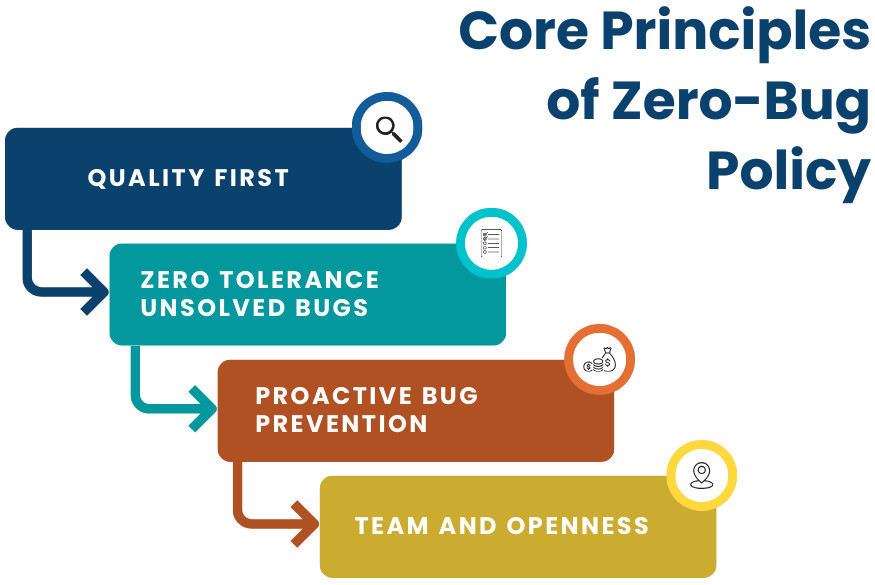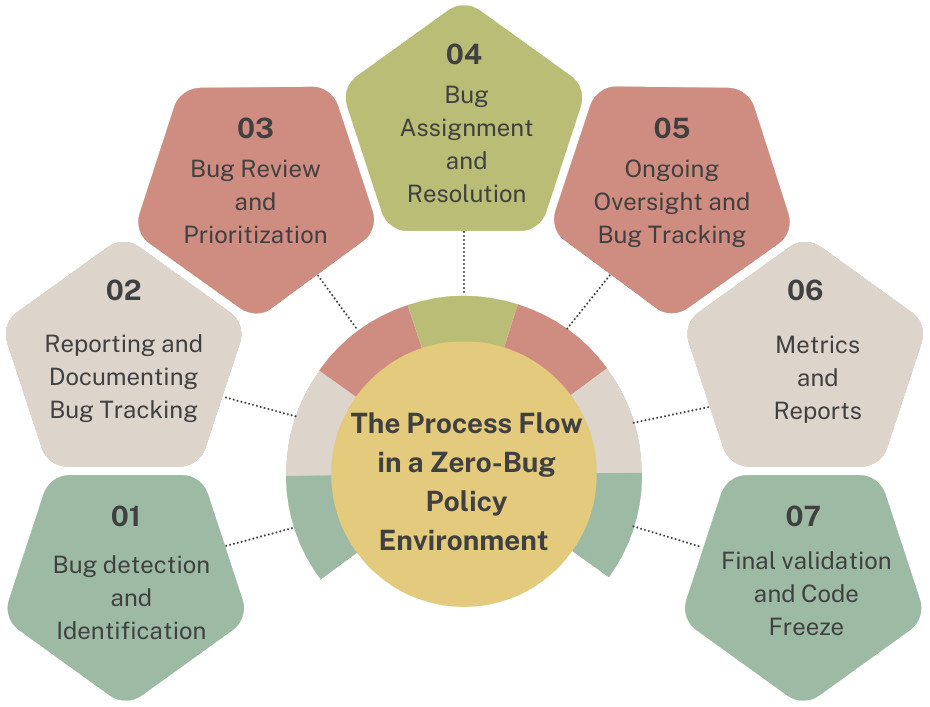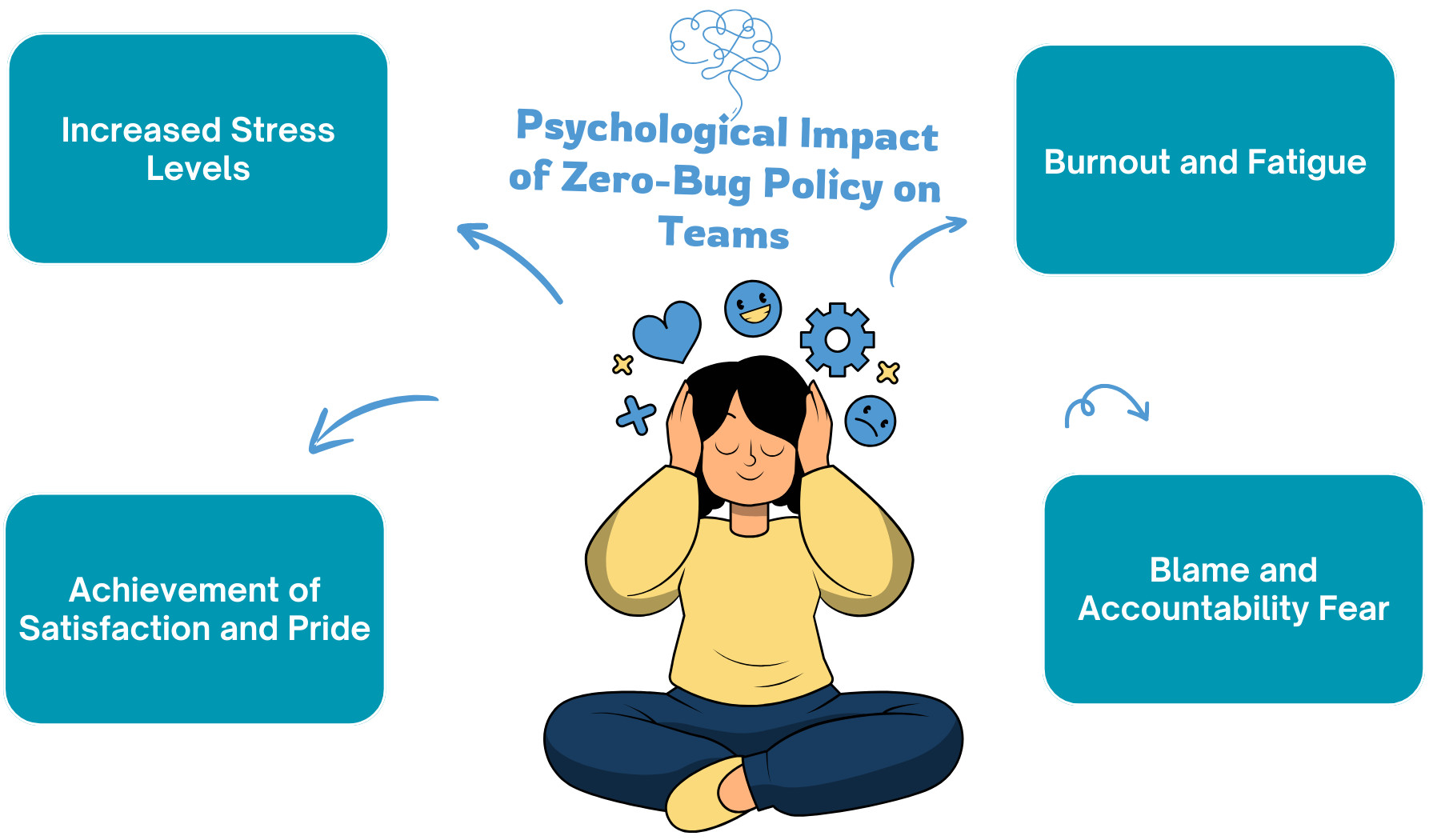What Is Zero-Bug Policy
|
|
The Zero-Bug Policy (ZBP) is an important strategy in software development since it has become vital in the high-quality development of software in the dynamic software world. The simple yet powerful theory here is that, when a bug is detected, it then has to be rectified and debugged before the software will progress in its lifecycle. ZBP is concerned with the end objective of having clean, well-tested code and reliability of the software to the highest levels prior to software deployment. The ZBP is also challenging the status quo, though, since development teams are required to work on even the tiniest of bugs just as they surface.
| Key Takeaways: |
|---|
|

What is Zero-Bug Policy
The Zero-Bug Policy is less about perfection and more about mindset. It is about treating bugs as unacceptable debt that should be cleared before moving forward. In many teams, bugs are tolerated, tracked in a backlog, and sometimes left for months or years. ZBP flips this thinking:
- If a bug is worth fixing, fix it now.
- If it’s not worth fixing, close it.
- Never let defects accumulate in a long, stale backlog.
This philosophy stems from Lean manufacturing principles, particularly the Toyota Production System, which advocates stopping the production line when a defect is detected (the “andon cord” principle). Read: Scrum vs. Kanban vs. Lean: Choosing Your Path in Agile Development.
Zero-Bug Policy: Core Principles

- Quality First: Zero-Bug Policy emphasizes the fact that quality should always dominate the software development life cycle processes. All defects are perceived to lead to improvement, and there is no source of a bug that is taken to be insignificant.
- Zero Tolerance Unsolved Bugs: The key to the Zero-Bug Policy is zero tolerance of bugs. The point behind that is everyone should move the idea that no bug, be it a cosmetic one or a critical system flaw, should be left in the system when it is ready to be released.
- Proactive Bug Prevention: One of the main ideas of the Zero-Bug Policy is better prevention. Rather than merely concentrating on correcting bugs once they have been identified, the policy appeals to the team to initiate actions that will, in turn, avoid the emergence of bugs altogether.
- Team and Openness: The ZBP stresses the role of team and transparency during the development process. The role of maintaining a bug-free product is in the hands of everyone in the development process, including the product developers and the quality assurance (QA) engineers.
Why Zero-Bug Policy Exists
Bugs may have very serious implications in the current cyber world in software development. One bug may cause a crash of the system, poor performance, or may have some security issues that can compromise user data. Bugs also become more difficult to follow over time in an increasingly complex system, which means that it is a necessity to eradicate them as they appear.
- Among the primary purposes of ZBP is to improve the user’s experience. Signs of bugs in software are commonly the appearances of painfully slow performance, crashes, or unexpectedly ineffective functionality. This happens to affect the satisfaction of the end-users directly. Development teams promoting the Zero-Bug Policy make sure that the software they provide to users will be refined, convenient and not full of annoying bugs.
- In today’s competitive market, trust is everything. If a product repeatedly has bugs or problems, customers may lose trust in the brand. The implementation of ZBP demonstrates that companies are willing to provide confidence in the products they give users and clients.
- In software development, technical debt is characterized by the build-up of problems that are left unaddressed, such as bugs, which can complicate any further development. Delaying bugs to future releases only adds to the technical debt that the system might eventually cause system instability, performance slowness, and the cost of maintenance.
Misconceptions About Zero-Bug Policy
Among the most widespread myths regarding ZBP is that none of the bugs can ever be found during the development process, and that the software needs to be absolutely perfect with no problems in it when it is even launched. This is not a correct interpretation because the Zero-Bug Policy does not act as a policy that dictates the idea that bugs should be avoided altogether. Rather, attention has to be given to every bug as soon as it is identified.
The second myth is that the Zero-Bug Policy will make the development go slower as it requires every bug, as well as the smallest ones, to be fixed. There is an opinion that putting more emphasis on bug-fixing will cause teams to run short of deadlines and fail to meet the features on time.
Many believe that the Zero-Bug Policy means achieving a bug-free software release, which might imply that no bugs should exist at all. However, this can be an unrealistic expectation, particularly in large, complex systems. The Zero-Bug Policy isn’t about absolute perfection but about proactively managing and resolving defects before they become problems.
Types of Bugs in the Context of ZBP
In the context of a Zero-Bug Policy, understanding the different types of bugs, such as functional, security, and performance defects, helps teams address issues effectively without letting them accumulate.
- Functional Bugs: They refer to those that arise when the software under consideration fails to work properly or perform the intended operation properly. In ZBP, the software can only be released when all functional bugs have been eliminated. For example, a save button in an application that does not save anything upon clicking.
- Performance Bugs: They change the responsiveness, speed, and efficiency of the software. Such bugs may not directly break the application but contribute to low performance, high resource utilization, low responsiveness, among other elements, which worsen the user experience. Read: What is Performance Testing: Types and Examples.
- Security Bugs: They are flaws that cause the software or system to undergo/experience security gaps like unauthorized access, data breaches or exploitation. Under the scope of ZBP, security vulnerabilities are fixed as highest priority bugs which should be solved at once to avoid the possible dangers to the users or the system. Read: Security Testing.
- Usability Bugs: These bugs usually revolve around a user interface (UI) design issue, ineffective navigation, confusing workflow, or anything with the software that renders it hard or frustrating to use. Examples include poorly labelled or otherwise inappropriately placed buttons on a page. Read: Automating Usability Testing: Approaches and Tools.
The Process Flow in a Zero-Bug Policy Environment

The Zero-Bug Policy (ZBP) environment process flow is a recurring cycle with a well-organized structure to see all bugs in the program recognized, monitored, prioritized, and remedied prior to release of the software into production.
- Bug detection and Identification: It starts with the discovery and the identification of bugs at different stages of development, be it, in the design, in the code, in the test or user response. Bugs can be discovered by programmers, quality assurance testers, or even test automation.
- Reporting and Documenting Bug Tracking: When a bug is specified, it is reported and registered in the bug-tracking system. A bug report contains bug description, steps to reproduce, severity level, priority level, affected components and screenshot/logs. Read: Minimizing Risks: The Impact of Late Bug Detection.
- Bug Review and Prioritization: Bugs undergo a review period where the seriousness and the implications are determined after reporting. All bugs in a ZBP environment are critical, but some may require being addressed with the earlier instance based on its effect. Read: The Strategy to Handle Defects in the Agile Development Methodology.
- Bug Assignment and Resolution: Priority bugs are then handed over to the right developers or groups to solve. In such an environment of Zero-Bug Policy, the core value of immediate action works. Bugs are not allowed to pile up, and they are solved on the fly. Read: Mastering Defect Management: Understanding Severity vs. Priority.
- Ongoing Oversight and Bug Tracking: With a ZBP, one constantly monitors. Immediately, bugs are flagged, analysed in real time, and resolutions are also followed.
- Metrics and Reports: It will be prepared regularly so as to keep track of the number of bugs, their seriousness and the time at which they are fixed to ensure that the group is on course.
- Final Validation and Code Freeze: After all known bugs are worked out, the application moves to code freeze.
Strategies for Implementing Zero-Bug Policy in QA
Implementing a Zero-Bug Policy requires a structured approach that blends process adjustments, clear guidelines, and team alignment to ensure defects are addressed swiftly and consistently.
- Create a Proper Structure of Bug Reporting and Bug Tracking: The system with centralized bug reporting is critical in management and addressing bugs in real time. The main steps necessary to implement ZBP successfully are to have a clear and consistent bug-tracking method that will make sure that every bug is captured, classified, allocated and fixed, and the overall system works in a highly efficient manner. Read: Defect Lifecycle.
- Rank Bugs on the Basis of Severity and Impact: Not all bugs have equal impact. In ZBP, it is very important to distinguish between bugs based on their severity and effect on the software. Although all bugs should be tackled, the most critical bugs, which may prove fatal to the software, should be corrected at once.
- Integrate Continuous Testing into Development Cycle: One factor that facilitates ZBP is continuous testing which is used to discover bugs as early as the development process allows. Automated and manual testing at all stages of development must be adopted so as to guarantee the presence of bugs and their fast resolution.
- Put a Good Code Review Process in Place: A thorough code review process should be adopted to avoid introducing bugs into a codebase. Code changes must be reviewed by peers prior to being merged so that they can be identified early enough and never reach the software to cause defects. Read: How Code Reviews Help QAs.
Psychological Impact of Zero-Bug Policy on Teams
The Zero-Bug Policy significantly influences team dynamics by creating a culture of accountability, pride in workmanship, and collective ownership of product quality.

- Achievement of Satisfaction and Pride: Some of the good psychological effects of Zero-Bug Policy include the effect of accomplishment and pride gained as a result of producing a product with no known defects.
- Increased Stress Levels: Although ZBP may induce a sense of achievement, it may also result in persons on the team feeling more pressure and stress.
- Burnout and Fatigue: The rigor and alertness it takes to have a Zero-Bug Policy setting with ensuring a bug-free environment all the time may ensure that a task subjected to this kind of environment may experience burnout and forms of fatigue.
- Blame and Accountability Fear: Zero-Bug Policy may result in a blame culture, in case bugs are not fixed in time or when a problem goes into production. All the pressure to fix the bugs as soon as possible may lead to the situation when developers feel afraid of being held responsible in case the problem appears, no matter whether it depends on them or not.
How Zero-Bug Policy Influences Release Management
In ZBP, the release cycle is made longer to ensure that all bugs are dealt with. This may create a potential backlog to the schedule of release, especially when bugs are found near the proposed date of release. Depending on the complexity of each bug, ZBP demands immediate bug fixing; as such, development teams may have to extend their project duration to test, correct, and verify every issue in the software.
ZBP is highly concerned with the QA during the release management process. As all bugs need to be fixed prior to the final release, QA teams are instrumental in testing the software completely and ensuring its flaw-free nature. Using ZBP, the standards to be put in place when releasing software are well defined to the extent that only software that is error-free and fully functional gets to production. In this regard, the Definition of Done (DoD) would be much tighter, where a release could be called done only when there are no open defects, even at the minimal level.
Zero-Bug Policy is in great alliance with Continuous Integration/Continuous Deployment (CI/CD) pipelines, and synchronized integration is essential between development, testing, and deployment workflows. As ZBP requires that there is zero number of bugs in the system at any point, the CI/CD pipelines should be conditioned to test automation throughout development to find bugs early enough and verify that any piece of coded work is of high quality.
Zero-Bug Policy vs. Traditional Defect Backlog Management
The Zero-Bug Policy (ZBP) and traditional defect backlog management represent two fundamentally different mindsets in handling software defects. While both aim to maintain product quality, their approach to defect storage, prioritization, and resolution diverges significantly.
| Aspect | Zero-Bug Policy (ZBP) | Traditional Defect Backlog Management (TDBM) |
|---|---|---|
| Philosophy & Method | Fixes all bugs immediately, no bugs carried forward; product must be bug-free before release. | Bugs are logged in the backlog, prioritized, and may be fixed later; some bugs can be deferred. |
| Bug Resolution Time | Immediate fixation of bugs, even at the last stage of development. | Flexible timing; bugs can remain unresolved for weeks, months, or even multiple releases. |
| Impact on Release Timelines | Can delay releases since all bugs must be resolved before release; ensures higher stability. | Faster releases are possible since minor bugs can be postponed. |
| Quality & Risk Management | High quality assurance, continuous testing, and lower risks as bugs are eliminated early. | Higher risk; unresolved bugs may cause user dissatisfaction, failures, or security issues. |
Challenges in Implementing Zero-Bug Policy
Implementing a Zero-Bug Policy can be challenging because it requires a cultural shift, disciplined processes, and consistent stakeholder buy-in to sustain its strict approach to defect management.
- Slow Development Time and Late Releases: Delayed release cycles are one of the greatest risk factors of ZBP. Since the policy requires that all bugs should be resolved prior to the release of the software, any defect, even a small one, has to be resolved, which may increase the duration of the development process.
- Development Team Pressure and Stress: The pressure to fix bugs as soon as possible can cause a culture of pressure especially when the deadline is close by.
- Resource Allocation and Overruns in Cost: Resources, both time and manpower, could be a burden whenever each bug has to be dealt with. Read: What is the Cost of Quality in Software Testing?
- Harder to Handle Non-Critical Bugs: Where ZBP is concerned, all bugs must be resolved irrespective of their severity. However, it is reasonable to give a higher priority to critical bugs as well as to minor or cosmetic bugs.
Conclusion
The Zero-Bug Policy is not about achieving literal perfection, but about building a culture of discipline, speed, and focus on user experience. In a world where speed of delivery often overshadows quality, ZBP provides a framework for balancing both. When implemented correctly, it reduces technical debt, boosts morale, and improves product stability, making it a cornerstone of modern software engineering excellence.
| Achieve More Than 90% Test Automation | |
| Step by Step Walkthroughs and Help | |
| 14 Day Free Trial, Cancel Anytime |












